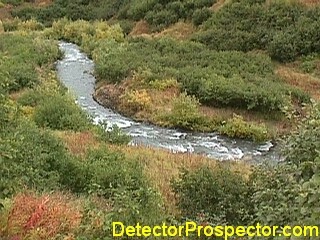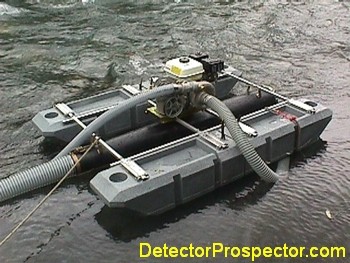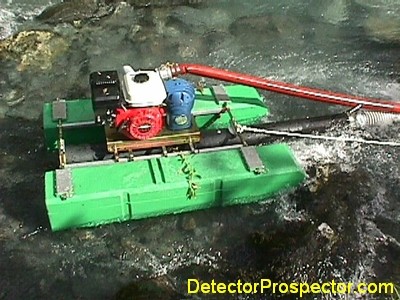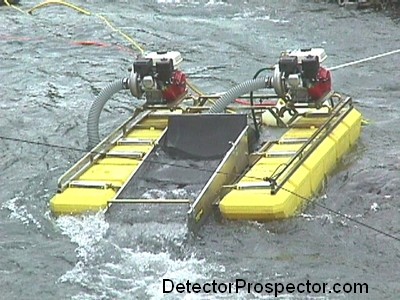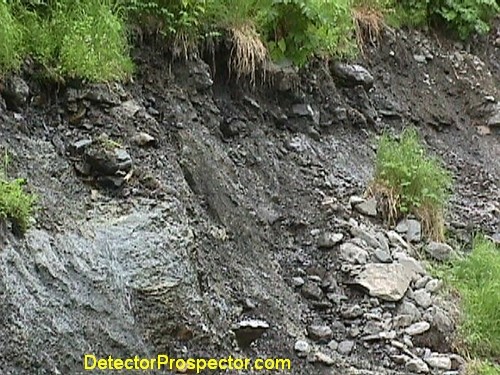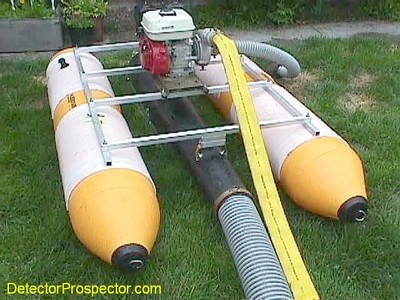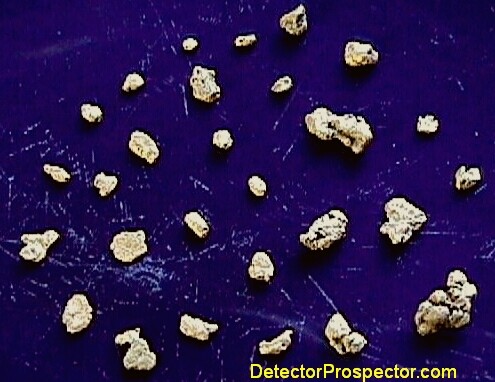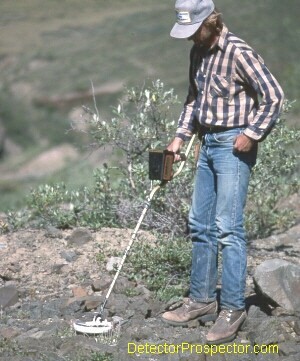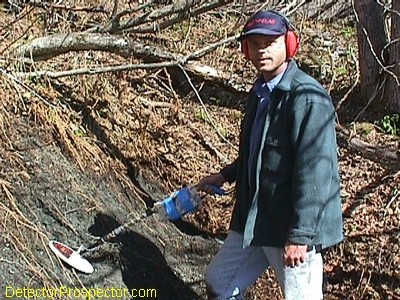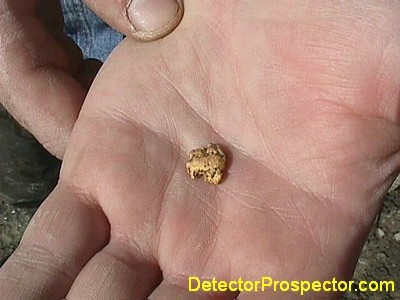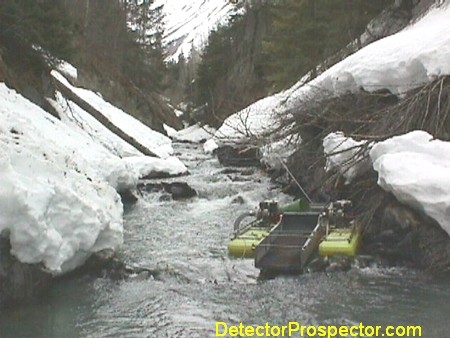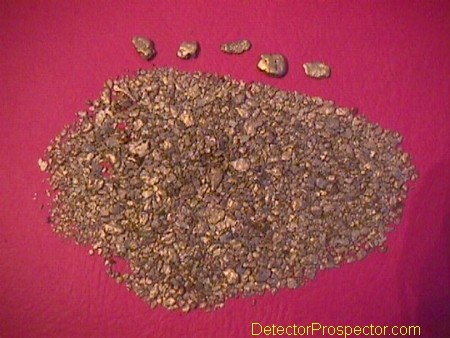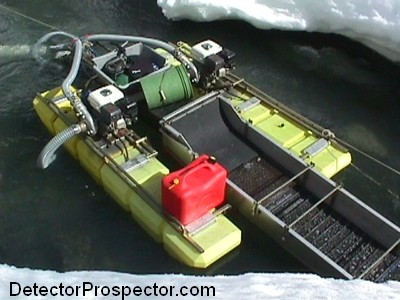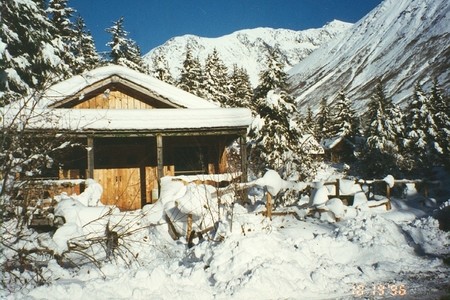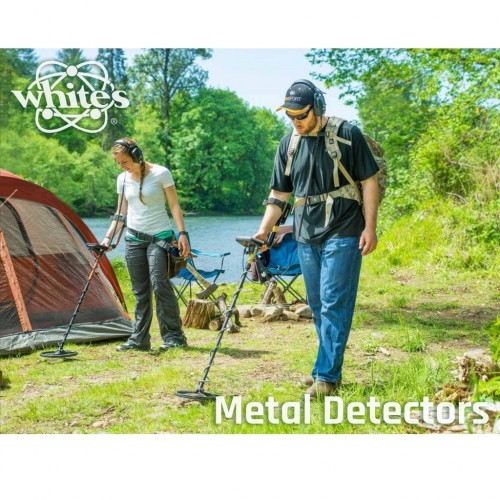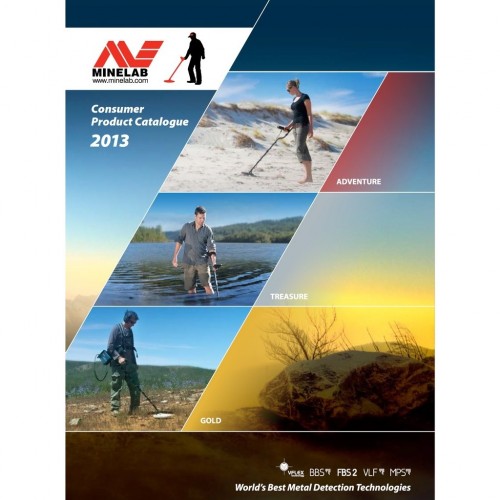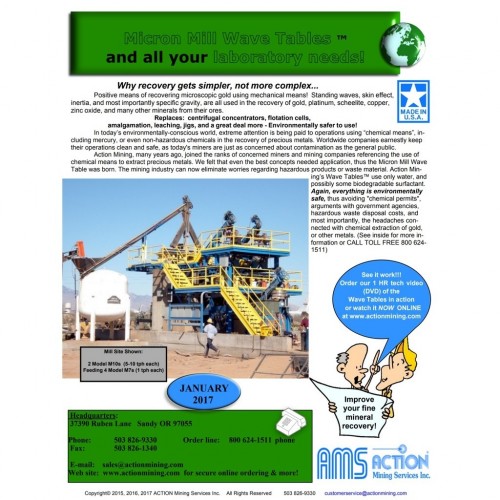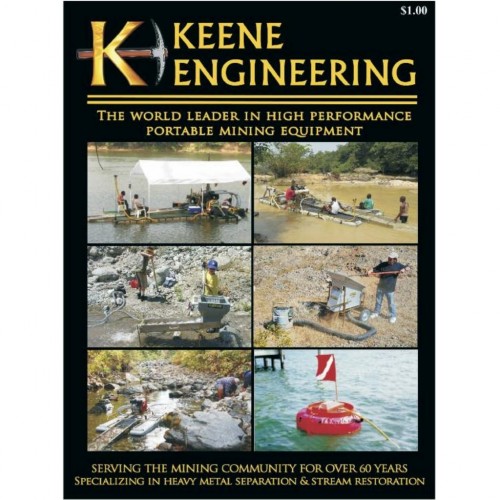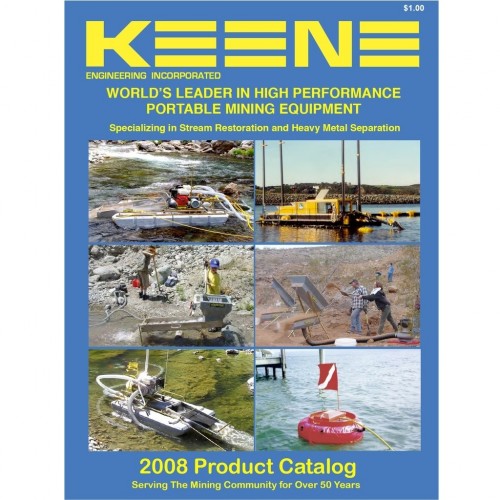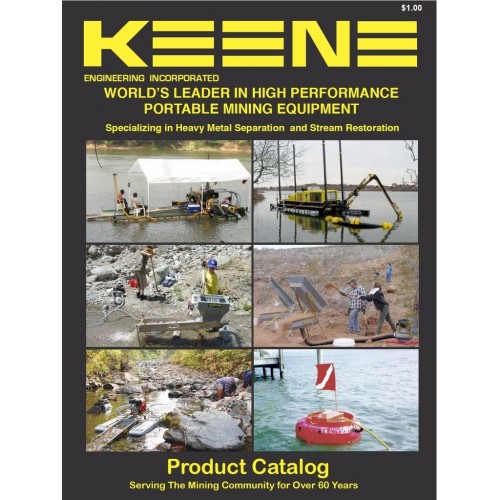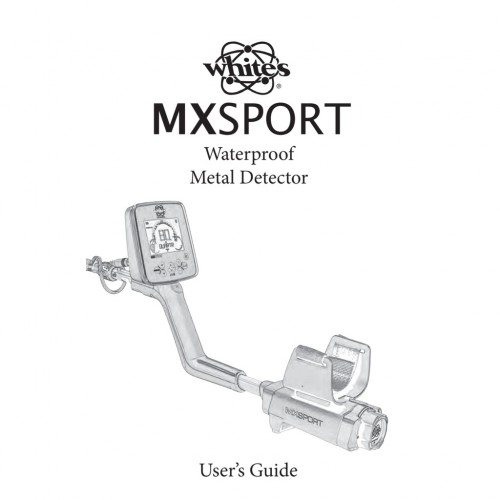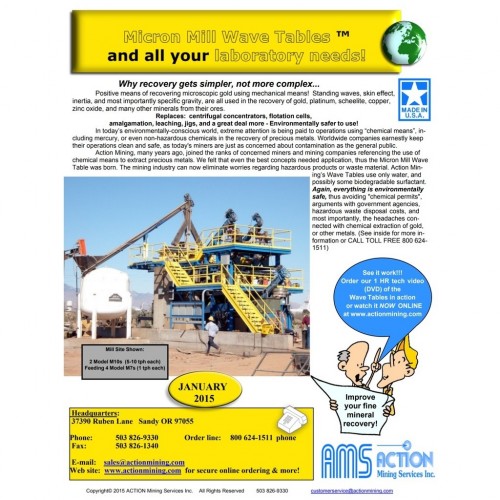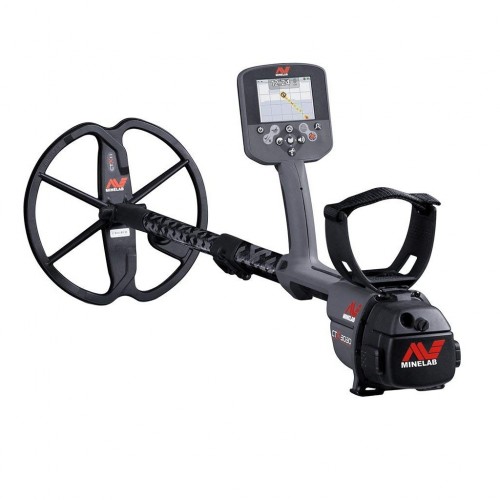-
Posts
19,735 -
Joined
-
Days Won
1,565
Content Type
Forums
Detector Prospector Home
Detector Database
Downloads
Everything posted by Steve Herschbach
-

Gold Mining at Mills Creek, Alaska - 9/5/99
Steve Herschbach posted a article in Steve's Mining Journal
The fireweed have ceased to bloom, and snow has appeared in the high country. Snow in this part of the country normally appears on the mountain peaks in early September. Fall is a very short season in Southcentral Alaska, with only six to eight weeks between the first appearance of snow in the mountains and serious snow at sea level. I headed up to Mills Creek Sunday morning and proceeded to setup camp. I had acquired a steel tube and tarp frame tent for the trip, and was anxious to try it out. I often camp out in the back of my truck for short trips, but as I had a couple of weeks off, I decided more room was in order. The tent is 10x13 feet and 6 to 9 feet tall. I outfitted it with an old military woodstove given to me by Al Adams (Thanks Al!). The extra room, plus propane stove, propane lamp, and small propane heater all seemed quite luxurious compared to my normal Spartan camping style. My father and cousin were coming up later in the day to spend the night and do a little gold mining. I headed out to meet them at the creek crossing, and found they were already almost to camp, engaged in clearing excess alders from the trail in. I helped them finish up the trail work and we got back to camp. They helped me set up the rest of the campsite, and then we headed down to do a little gold mining. We crossed the creek and proceeded to use my metal detector to search bedrock along the creek just above my dredge site. We immediately started finding some rather nice gold, ranging from match head to little fingernail sized pieces. My father was checking the side of a very steep bedrock outcropping when he got a very loud signal about six feet up above the water. I was surprised when the target turned out to be a very nice two pennyweight nugget lodged in a small pocket in the side of the outcropping. Frame tent at Steve's camp and faithful mining dog, Kirby It started to rain quite hard, so we decided to call it a day. My cousin, Bob Herschbach, cooked us up a great meal. I usually just heat up a can of stew, or some other simple fare, so it was a treat to have someone cook up a real meal. We turned in for the evening, and discovered one of the drawbacks of living in a tent. It rained hard all night, and gusts of wind periodically hit the tent, causing quite a bit of noise. It made it hard to sleep but I finally managed to doze off. We arose Monday morning to find the creek had risen tremendously, and the clear water had turned a thick gray color. Bob was visiting us from Missouri, and had a plane to catch home the next morning, so we were a bit worried as to whether we would be able to get him out in time, as the creek must be crossed to get back to the highway. It had stopped raining, however, so we hoped the water level would drop later in the day. Since the water made crossing risky, we looked for new digs on our side of the creek. Some old channels and hand stacked rock piles are in the brush across from where I was dredging, so we checked bedrock along the creek in that area. Once again, we started finding some nice gold. By the time Bob had to head out that afternoon, they had found about 1/2 ounce of nice nuggets, including the previous afternoon's finds. The water had come down, and Bob and my father were able to head back to town. Now it was just me and my faithful Golden Retriever, Kirby. As we settled in for the evening, I planned the next days activities. I was impressed by the size of the nuggets we found on the near side of the creek, where the old channels dump in from the side. I decided that perhaps gold from these old channels had formed a paystreak where they had emptied into the main channel, and also that the old-timers tailings would have dumped in at these points as they worked the channels. Any gold they lost would end up in the creek along the near side. I decided to bring my dredge across the creek and try the area just below where we sniped gold on the bank, and work up towards that location. Bob & Bud Herschbach sniping bedrock, and their gold Tuesday morning was spent getting my dredge across the creek. The water had come down, but was still high, and it took careful work to get the dredge across the creek. I spent more time removing rock from the dredge site, then started dredging. I only dredged a short time, but got a couple of pennyweight of smaller gold. Wednesday I got up, and plain felt lazy! I had a good book with me, and kicked back and read away the morning. Jeff Reed showed up around noon to report that he might come up later that afternoon to do a little bench mining. I decided to get back to work, so after waiting to see if Jeff would show back up, I suited up and got back to dredging. I uncovered quite an expanse of bedrock, but the deposit of coarse gold I was hoping for did not appear. There was gold, but only small amounts scattered about in bedrock crevices. I had about 1/4 oz of gold by the end of the day, and in general the gold was smaller than what we had sniped off the bank just above! I did find one nugget that was over half quartz, a departure from the well worn and solid character of the gold normally found here. I headed down the creek to check up on Jeff, as I did not see him back up in my area. He had gone back up the creek with his 4" subsurface, and reported that he was not doing very well. The section of creek he was working turned out to have smooth bedrock, and no gold was being held for him to find. I invited him up to my area if things did not improve, and went back up to my camp. Thursday I continued to work the site, but the area did not improve. Working up the creek, and out nearly to the middle of the channel exposed no real concentration of gold, just sporadic deposits in crevices. Again I got about 1/4 oz of gold. Not enough to really keep my interest in the site. I began to consider moving back across the creek, but figured I had about one more days worth of dredging to finish up material I had exposed. Thursday night was horrible! It started to rain very hard, and increasingly hard gusts of wind developed. By around 9PM the gusts were up to the 50-60 mph range, and my tent was taking a beating. It was very well staked down, but each gust that hit puffed up the sides and roof, and then sucked them back in. It was very noisy, and somewhat nerve-wracking, wondering if the whole thing was going to fly down the valley at any minute. Poor Kirby probably thought the world was ending, and both of us could not get to sleep. I finally gave up and we both crawled into my truck at midnight. The back was full of gear, so I slept in the front seat, and Kirby curled up in the passenger seat. It may not have been as comfortable, but it was much quieter, and I finally got a little sleep. Friday morning the rain was coming down in sheets, and the wind had not let up at all. My tired, cramped body stared at out the weather and thought "This is nuts!" Kirby agreed, so I quickly tore down camp, secured the dredge, and got the heck out of there before the creek flooded so high that I could not get out. We got back to Anchorage and I spent the weekend doing odds and ends. Steve's dredge site and 5" subsurface dredge I returned Monday morning and found the water was still pretty high. I had decided to try and get my dredge back over to the far side of the creek, but was barely able to cross the creek in my drysuit without a load, let alone carrying/dragging any equipment. I could have dismantled the unit, carried it upstream to a better fording area, carried it back downstream and set it up again, but it seemed like too much work when the area I wanted to move to was only fifty feet away. I decided the time would be best spent prospecting for a better spot to dredge, so I got my sniping tools and proceeded to check bedrock along the sides of the creek. I did finally find an area on the far side and downstream of my dredge that shows promise. I found what appears to be a layer of virgin pay material resting on very decomposed bedrock. The material is a rich yellow/brown color and fairly compacted. Working the area by hand on Monday and Tuesday produced about 1/4 oz of gold. The gold is distributed throughout the yellow layer and in the underlying bedrock. What struck me most was the gold mixed in the material, as most material on upper Mills Creek seems relatively barren, with the gold heavily concentrated on bedrock. This tends to make for spotty dredging, but if I can get into a stretch where the material has gold in it, dredging can be more productive. I traced the deposit for some distance and it looks to have good dredging promise. Unfortunately, the weather continued to go downhill. September is our rainiest month, and this one was proving to be no exception. By Tuesday night the rain was continuous, and by Wednesday morning I decided to pull out and wait for better weather conditions. I want to move my dredge to this potential new site and try it out. When I got back to town, my father contacted me and indicated he and my brother Tom were interested in going back up to Mills to try some more detecting on the banks. They met me Thursday morning in Anchorage, and we arrived at the Mills crossing at about noon. Mills Creek was a raging brown torrent. I paused in my truck, thinking it looked too deep to cross. Since I had my Dad behind me, and a long chain in my truck, I foolishly forged on ahead. I made it about 1/3 across, when my motor stalled. Then I noticed my feet were getting wet. Looking down, I saw water coming in under the doors! Luckily, after a little coaxing, my motor restarted, and I was able to back out. After a brief stop to bail the water out of my truck, we retreated to Crow Creek Mine, and spent the night camped out in one of the cabins. We did find some gold metal detecting before turning in for the evening, so the day was not a total loss. My brother and I looked the creek over for potential dredging sites, as I plan to move my dredge here after giving Mills Creek one more shot. I'm probably going to try the upper areas of the creek, in hopes of finding some nicer sized nuggets. 1/4 oz and larger nuggets are relatively common in the upper areas of Crow Creek Mine. We were back at the Mills crossing by 10:30 Friday morning, and the water, though lower, still looked quite high. I now had a better idea of what my truck would handle due to my failed crossing attempt the day before, so we decided not to push it. We headed back to Crow Creek, and detected some more gold. We ended up with a couple dozen small nuggets before deciding to head back to town. Mills Creek gold and close-up of quartzy nugget My total finds for several days dredging and sniping came to 17.4 dwt, not counting the nuggets found metal detecting and sent home with my father and cousin. Those finds probably added up to a little over 1/2 oz of gold. I am currently back at work for the week, and plan to head back to Mills Creek on Saturday, October 2nd. It is Wednesday as I write and the weather does not look good. It has rained all night, and the forecast is for more clouds and rain. I face the prospect of continued high waters at Mills Creek, plus the increasing risk of an early snowfall, which could trap me and my gear high in the mountains. Two years ago heavy snows fell October 10th. I would like to evaluate the new paystreak I found at Mills with my dredge for a couple of days, but will probably pull my gear out and move to Crow Creek for the remainder of the season unless conditions improve. The water is dropping at Crow Creek and is clear enough to dredge now. ~ Steve Herschbach Copyright © 1999 Herschbach Enterprises -

5" Subsurface Dredge at Mills Creek - 8/21/99
Steve Herschbach posted a article in Steve's Mining Journal
Fireweed bloom in the fall on the year, and Alaskan lore says that when the fireweed cease to bloom, winter will be close at hand. So it is that when I look at the hills blazing with fireweed in the sun, I cannot help but think of the winter soon to come. Hopefully, before the ice freezes thick on these mountain streams, a few more ounces of gold will see the light of day. I spent Friday evening loading up my 5" subsurface dredge. Since I have retired my 6" dredge, this will be my workhorse in the future. I am very pleased with the unit, which is incredibly more portable and uses half the fuel of my old dredge. I was thinking of bringing my 4" subsurface to Mills, but decided the small extra weight was worth the extra capacity to move gravel. This is the same unit I used at Mills Creek last summer, but with marlex floatation instead of the inflatable pontoons. I decided I liked the durability of the marlex over the compactness of the pontoons. I took all of Saturday to clear a trail to my worksite and set my dredge up. I prepared to go over some ground below a bedrock outcropping where I had found gold last year. It is a good thing we have long daylight hours in the summer, as I worked until 9PM to get everything ready for Sunday. Sunday I put in a long day of dredging. I worked from 10AM until 9PM and got roughly 10 hours of dredging in. The dredge worked well, and I did find gold, but had to work for it. The gold was evenly dispersed over a wide area in bedrock crevices. There was little gold in the overlying material, and so the day was spent splitting crevices open to reveal the gold inside. Unfortunately, this is time-consuming work, and I ended up with 1/2 ounce of gold for the day; about 1 pennyweight per hour. Not exactly getting rich quick, but not bad for a new area. One nugget was just over 1 pennyweight. The subsurface box did well on the rather substantial amount of finer gold that was recovered from the crevices. Steve's 5" Subsurface Dredge at Mills Creek I had taken Monday off from work, so put in about 5 hours more dredging, with similar results of about 1 pennyweight per hour. This gave me another 1/4 ounce of gold, or 3/4 oz for the weekend. The gold is a little smaller than that from downstream, but I hope that is just because of all the bedrock splitting. I hope to get into some coarser gold in the deeper, faster water areas. The area was pleasant to work, however, with shallow bedrock and relatively slow water, so it was a real pleasure compared to most of my dredging at colder times of the year. Jeff was working downstream but I did not see him at all over the weekend. I was just too tired each night to make the trip downstream to visit. By the time I put my dredge up and pulled up camp, he had already left for home. When I got back to work Tuesday, He revealed that he had found just over an ounce of gold, and that the hot streak had played out, so he had moved upstream a little. Steve's gold from Sunday and Monday Now that I have my dredge on-site, and have a basic campsite set, I will be able to concentrate more on mining in the coming weeks. I have hopes of reasonable gold in this stretch of creek, with plenty of material that is workable even at higher water levels. Jeff and I both plan to take off significant amounts of time in September to mine at Mills Creek. Hopefully the weather cooperates by not getting too rainy. ~ Steve Herschbach Copyright © 1999 Herschbach Enterprises -

4" Subsurface Dredge at Mills Creek - 8/15/99
Steve Herschbach posted a article in Steve's Mining Journal
Summer passes too quickly in Alaska. August has the last hot days of the year, but the weather usually turns rainy. By September snow will start to appear on the mountain tops, and by the end of October snow arrives at sea level. I am trying to plan my fall operations, but the weather is always a question. I am afraid that the rains and high water of September will turn to snow and cold weather quickly this year, leaving only a short dredging season. The current plan is to work at Mills Creek first, and then possibly at Crow Creek later, depending on weather and gold. My mining buddy Jeff Reed decided to move his 4" subsurface dredge up to Mills Creek and start working. He had marked out a stretch of creek that had very productive sniping (extracting gold with simple hand tools) last year and wanted to hit some of those same areas with a dredge. The gorge I had marked out for myself upstream of Jeff's ground was still full of whitewater, and it made me rethink my position. Here Jeff was starting mining, and I was still waiting for the water to go down. I decided to look for an area further upstream that would be more suitable for dredging at higher water levels, as I want to do some dredging before it gets cold this year. I can then go after the gorge when the weather gets cold and the water level drops. Jeff's 4" Subsurface Dredge at Mills Creek The pictures above show Jeff's dredge. It is based on a new 4" subsurface sluice box by Keene Engineering, bolted between a small set of marlex floats. A 4HP Honda pump provides plenty of power for the dredge and air compressor. The entire unit, with 15' of suction hose and suction nozzle weighs just under 100 lbs. These units are nice for remote sites, as they weigh less and use less fuel than the equivalent surface dredge. The trade-off is some loss of fine or flaky gold, but I have found it to be an acceptable trade for the areas I work. I hiked up the canyon to where the valley starts to open up, and located a very nice stretch of creek on a wide, sweeping bend below a waterfall. I had found gold in this location last year, so made the decision to move my markers up to this site. It is far enough upstream that I will have to abandon my normal campsite (pictured at the top of the page) and move upstream. The area is set in a beautiful alpine meadow, so I do not mind making this move, although the road up to this area will require some clearing. It is amazing how fast alders grow in Alaska's long daylight hours. Views from camp down to creek and looking up valley I will be camping on a hill overlooking my future dredge site, so it will be a short walk down to the worksite each day. I plan to set my dredge up in the lower portion of the on the inside curve (the upper left hand corner of the picture on the left). I'll proceed up the creek, generally hugging the inside of the curve. Bedrock is quite shallow, with no more than 1-2 feet of material in much of this area. Satisfied with my new plan, I headed down to see how Jeff was doing. He had about 3 pennyweight (20 pennyweight per troy ounce) of nice gold as I came by, and had the rest of the evening and the next day left to dredge. I had to work the next day, however, so headed on back to Anchorage. When Jeff came back to work the following day, he had 2-1/4 ounces of very nice gold gold to show off, with quite a few nuggets weighing over a pennyweight each. His dredge had worked well and he got into a small, but hot stretch of crevices in the bedrock. His showing of gold certainly has me anxious to move my dredge up to Mills Creek the next weekend! Jeff with weekend's gold ~ Steve Herschbach Copyright © 1999 Herschbach Enterprises -
It is a fact that a lot of the very best mining ground is already claimed. The diligent prospector can find new ground, or careful study of claims records can sometimes reveal a claim that has lapsed and can be restaked. These methods are time-consuming, and the ground acquired is still not usually the best. Excellent mining ground tends to be claimed, and these claims rarely lapse. This leaves working out permission to access claims, whether on percentage or lease deals, or the outright purchase of mining claims. When it comes to purchase, the problem becomes money. When that good deal arises, money can be all that is lacking. In 1997 a group of mining claims on Mills Creek on the Kenai Peninsula came up for sale. This creek is one of the better producers historically on the Kenai Peninsula, and so attracted my attention. Unfortunately, I did not have the funds to buy the claims outright, and so did not pursue them. Luckily, some friends, also excited about the claims, decided that a group of us should pool our money to buy the claims. The idea was discussed, possible pitfalls worked out, and the purchase proceeded. So it was that I am now a member of the Mills Creek Cooperative. We made a group purchase of the claims, and agreed upon a set of rules governing the member's use of the claims. A written agreement of this sort is very important, so that minor (or major) misunderstandings can hopefully be avoided. Last summer some basic exploratory mining took place, and it was found that the ground contained good, reasonably coarse gold. Match head size nuggets are common, with nuggets up to several pennyweights found. I'll backtrack and add last years Mills Creek experiences to this Journal some time in the future. One of the agreements about our claims is that each dredger must mark a 300 foot stretch of creek as his current site of operations. These sites are first-come, first-serve, and are good as long as they are worked at least once each thirty days. I had let my old site lapse last fall, and decided it was time to pick a new dredging area for the year. My friend Darrell, who has recently arrived in Alaska, has never mined for gold before, so I invited him along for a little mining and camping. Camp at Mills Creek An old mining road leads several miles off the highway to our claims. This small road is normally designated as non-motorized access only, but our permits for the claims allow us to use vehicles on the road. This is very important, as the distance and elevation change would make bringing in equipment very difficult otherwise. It also provides a small measure of security, as non-miners are not allowed to access the claims with motorized equipment, somewhat reducing the problem of theft. The above photo is of my normal camp on the lower portion of our claims, where one branch of the road ends as it is pinched between the creek and a cliff. I marked off a 300 foot stretch of creek upstream, in a section where the water is forced through a small, vertical rockwall gorge. The water is fast and furious at this point, and it will not allow me to dredge until water levels drop in the next couple of months. This is fine, as it will allow me time to pack my equipment in, and do a little trail work. I'm hoping the bedrock gorge may have some nice pockets of gold. We sniped gold both above and below the section late last fall. The water in the gorge itself was deeper than we could check out with hand tools alone, so only a dredge will tell how good it is. Marshall & Lyle's worksite and Al & Kenny in the water Several of my partners were actively trying new ground in the lower, more open portion of the creek. All the work to date is being done with 4" and 5" dredges, with plans for a 6" dredge in the near future. I am currently planning on using a 4" subsurface dredge in the gorge. A few hours of panning bedrock exposures along the creek produced minimal results. Darrell and I then switched to metal detecting an area that had decent results last summer. Exposed bedrock along one side of the creek had produced numerous nuggets, but was fairly well picked over. A couple hours detecting located a dozen nuggets that were missed, however. This resulted in Darrell going home with a couple of pennyweight of nice nuggets, not bad for a first time mining trip. Gold putting a smile on Darrell's face! Everyone got gold, but no fantastic finds were made. Everyone was getting setup for the first time this summer, and getting the bugs worked out of the operations. I don't intend to do any real dredging myself until September, when water levels start to come down, but may get tempted to come up sooner. We'll just have to see what develops. ~ Steve Herschbach Copyright © 1999 Herschbach Enterprises
-

Old Stream Layers at Crow Creek - 7/10/99
Steve Herschbach posted a article in Steve's Mining Journal
I finally got my dredge completely out of Crow Creek canyon this weekend. Water conditions in the canyon forced me to don my drysuit; I did not feel comfortable trying to cross the creek in waders while carrying a six foot long sluice box over my head. I was tempted to leave the last items until the water dropped in the fall, but I already had a buyer for the dredge, and so had to get it out. After carefully fording the sluice, suction hose, and other gear up the canyon to the base of the cable pullout, I stripped out of my drysuit. Then came numerous trips in and out of the canyon, attaching gear to the pulley system, then climbing up and pulling it out. By the time I finally got it all out to the parking lot, I was ready for a break. Sluice headed up cable The pictures below explain why I dredge Crow Creek in the early spring and late fall. It has been a dry summer, but since Crow Creek is fed by a small glacier and snowfields, it remains at flood stage all summer. The water is fast enough to be barely crossable, and is gray with glacial silt. Compared with the slow moving, clear water of spring and fall, it is simply not worth fighting the season. In particular, the inability to see the material means more worthless material is dredged, and more frustrating hose clogs occur. Still, there are those who work the creek in the summer and do well; they simply have more patience than I have. Crow Creek on July 10, and back on April 24 I decided I had to find at least a little gold before I went home, so I grabbed my trusty metal detector and headed up the creek. Mine owner Sean Toohey was working with a backhoe up the creek grooming a place for a GPAA mining party the next weekend. He was also scouting for a place to mine in the future. A rather obvious (to my eye, at least) layer of cobbles was cutting across a bank exposed by floods a couple of years ago. A looser cobble layer rests on a finer grained, and much tougher lower layer. The fine-grained lower layer is much older, and formed a false bedrock surface for the more recent upper streambed layer. At one time Crow Creek itself was running up at this higher point, and the cobble layer represents the bottom of this now high and dry deposit. Remnants of older streambed material, perched above and parallel to the existing steam are referred to as "benches" or "high bench deposits". Often a flattened area on the banks above the current creek can indicate a bench deposit, but often times material sliding downhill from above bury the deposits so that they are not immediately obvious. Such is the case at this location. Old streambed layers exposed at Crow Creek I checked the exposure with my detector, and was not too surprised when I had found three small nuggets in less than ten minutes. They all were at the base of the cobble layer, on top of the fine-grained layer. They were also of a chunkier character than the gold found in the canyon downstream, having been subject to less stream action since being released from the gold veins upstream. The two larger pieces are 4 grains each, while the smaller piece is a 1 grain nugget, for a total of 9 grains. Not much, but not bad for ten minutes. Sean promptly declared the location "Steve's Bench" and made plans to expose the hillside with the backhoe in the future. Chances are the deposit is limited in extent, but one never knows until a little digging is done. In any case, the area bears more attention from metal detector users and others. Three nuggets ~ Steve Herschbach Copyright © 2000 Herschbach Enterprises -
Water conditions are now at peak spring melt levels, as warming temperatures melt snowfields and glaciers at higher elevations. There is certainly dredging to be had, but I prefer to just play around this time of year, and wait for the water to settle. It is a good time for moving equipment around, and to prospect and metal detect for gold. It is also a good time to do those household chores! The drive from Anchorage to Crow Creek Mine on the Seward Highway is a spectacular one. On one side of the road is Turnagain Arm, a glacial fjord. On the other side, cliffs rise into the Chugach Mountains. There area is rich in wildlife; beluga whales and even a rare orca (killer whale) are seen in the Arm. Eagles are common, and the mountains are dotted with Dall sheep, mountain goats, and bears. So it was that on this drive I had a chance to stop and take pictures of a Dall sheep next to the road, with a lamb perched on the cliff above. Dall sheep and lamb in Chugach Mountains I've been packing my 6" dredge out of Crow Creek Mine, where it has resided for the last couple of years. I've decided to sell the 6", and downsize to a 5" dredge. The 6" has been a very good unit for me, but recent regulatory changes in Alaska have made me decide to go to a smaller dredge. All dredges in Alaska must have an EPA permit. Dredges with a 4" nozzle opening and smaller require a free permit with a simple set of requirements. A more stringent permit, with reporting requirements, has been required of dredges with a nozzle opening larger than 4". Keep in mind that a typical 5" dredge, so designated by the manufacturers because of the hose size, usually has a nozzle opening of 4" to prevent clogs, and so would be designated a 4" dredge under these permits. As if it was not bad enough that larger dredges had a more stringent permit requirement, the EPA permit for dredges with a larger than 4" nozzle opening (the Medium Dredge permit) has expired as of June 30, 1999. This General Permit has not been replaced, and so now anyone wishing to use a dredge with a larger than 4" nozzle opening is in for a major permitting process. An Alaska Placer Mining Application (APMA) must be applied for. There is a $100 permit fee. This permit is reviewed by ALL applicable State and Federal agencies and is subject to public review and comment. It is advisable to file this permit no less than 6 months in advance. You must provide a detailed Plan of Operations, and you can expect the agencies to add additional requirements to whatever plan you submit. 2012 Update: Dredges with a less than a 6" nozzle opening are now considered "small dredges" and fall under a general permit with no special cost or reporting requirements. But as always, check for the latest rules as this page will no doubt be out of date when you read it. A process of this sort may be appropriate for a full-time, large scale dredging operation. It certainly is not for casual, weekend miners such as myself. The worst part of it is that if you wish to move to a new site, you must go through the whole process all over again. I've avoided the issue by restricting my nozzle on my 6" dredge to 4", which has made it a wonderfully non-clogging dredge, and allows me to operate under the EPA Small Dredge permit. Ultimately, however, I am carrying more equipment than I need, as a 5" dredge with a 4" nozzle will move nearly as much as a 6" dredge with a 4" nozzle, as long as care is taken to not clog the hose. I plan to use a 5" subsurface dredge. My dual 5.5HP engine 6" weighs about 400 pounds. A single 5.5HP powered 5" subsurface will only weigh about 150 pounds and will burn one-half the gas as the 6". I'll move about the same yardage, but at a higher percentage of gold loss per yard. In the areas I work, however, I feel the loss will be acceptable, when I consider packing 250 lbs. less equipment into remote sites. Add to that a reduction of 50% in fuel, and I'll save my back a lot of work! 5" Subsurface dredge on inflatable pontoons The pictures above are of a unit I built and used last fall on my claims on Mills Creek. It uses a 5.5HP Honda pump, running into a 5" suction nozzle that pushes the material back through 15' of 5" hose to the underwater sluice box. I liked the light weight of the inflatable pontoons floats, but I am worried about them abrading against rocks and sinking, so I plan to go to marlex floatation this year. The recovery system/sluice box on a subsurface dredge is underwater, with a riffle area about 8" wide by 24" long. The fact that you are not lifting the material above the surface of the water is what keeps the horsepower requirement small, which cuts the weight and expense of the dredge considerably. I have used these units often in the past, and am very happy with subsurface units in general. I plan to use the 5" subsurface on Crow Creek in the future. I have another, even smaller 4" subsurface that I plan on using at Mills Creek this year. Subsurface dredges have a higher gold loss than most surface units, but are MUCH lighter. A 5" subsurface dredge can be built that is as light as a 3" surface dredge and with the same pump. While it may have a higher percentage of gold loss per yard moved than the 3", the 5" will move 2-3 times as much material. The final result is that you will normally get more gold by the end of the day with a 5" subsurface than a 3" surface dredge. In areas with fine gold, and higher loss rates, the difference will not be as dramatic. In fact, in areas with extremely fine gold, the 5" may even get less gold even though more material is moved, as the loss rate can be very high on extremely fine, flaky gold. In areas with coarse gold, the 5" subsurface will get 2-3 times more gold as the 3" surface unit, as the loss rate on coarser gold is negligible. I frequent areas with coarser gold, and that tend to require a lot of backpacking, so the subsurface dredge is a great way to go for me. 19 Little gold nuggets! I spent part the day packing more equipment out of the canyon. I'm doing it a few loads at a time, and then spending the rest of the day playing. I wandered up the creek metal detecting and hit the area that I had found on my last trip up to the mine. No dramatic new results, just more small nuggets. A couple of hours metal detecting netted me 19 little nuggets, totaling exactly one pennyweight (1/20th troy ounce). At some point I will have to hit this area hard for a full days work to see what I can get. For now, however, it is simply a nice way to work in the morning packing equipment, and still get a little gold by the end of the day. ~ Steve Herschbach Copyright © 1999 Herschbach Enterprises
-
The problem with packing dredging equipment into a canyon is that someday you must pack it out again. I spent a good deal of Saturday and Sunday doing just that. The dredge had to be packed piece by piece up the creek to a log footbridge. There is a 100 foot climb up a rope above the footbridge, and then a short walk to the base of another steep hill. The distance is not too far, it is just kind of vertical! The photo above was taken during one of the previous weekends, so the snow is now gone. This kind of access is the main reason why I prefer the twin 5.5HP pumps on my dredge. I'd rather make two relatively easy trips, than one heavier and more dangerous trip with a large motor. After retrieving most of the equipment, I wanted to get in some nugget detecting. I decided to try and find some new detecting sites, as the previous weekend proved the old sites are getting a bit lean on gold. I have had my best luck detecting at Crow Creek Mine by following the surface of the old hydraulic workings. The old miners used pipes to bring water from a considerable distance upstream. This water was directed through large nozzles (giants) which were used to wash vast amounts of material through the sluicing system. The mine is actually an artificial valley, about 250 feet deep, created by the old mining operations. Looking down into Crow Creek canyon As the water and material was washed into the sluice boxes, gold settled into the surface of the material below. Much of the old Crow Creek operation never reached bedrock; the gravels were washed in a v-shaped cut into the sluice boxes. When they stopped mining, much of the gold was left in depressions and pockets in the surface of the mining cuts. A lot of this remaining virgin material, with its enriched surface layer of gold, can be found today, but it usually requires a bit of work. Worthless material caved onto much of the virgin ground, and later mining covered much in tailings. Finally, the area has grown a thick layer of brush, which obscures the terrain during most of the summer. Early spring is the best time to prospect for new sites at Crow Creek, before the lush vegetation sprouts up. I chose to use a Fisher Gold Bug 2 on this trip. While this is an older manual tuning design I am familiar with it and in the hands of a person who knows how to tune it the Gold Bug 2 can hit some very small gold. I have no problem in low mineral ground finding tiny pieces weighing a tenth of a grain or less (480 grains per ounce). I spent some time prospecting the tops of some steep slopes, but only found a few buckshot. I proceeded upstream, when a small bank of brown gravel along a side gully caught my eye. The main gold-bearing material at Crow Creek is a clay-rich yellow-brown color that is easily distinguished from the washed gray tailings. The tailings material is also very loose, while the virgin material is very compact and can require a pick to loosen at times. The picture above shows the gray tailings on top of the brown virgin layer. The boundary, where the gray meets the brown, is most often a very productive layer. Gray tailings over brown virgin material & small nugget on layer The tailings tend to have a lot of iron and other trash, and not much gold, so I rake it away from the brown layer. The detector is used to carefully check the surface of the brown layer for nuggets. The nuggets are often found around rocks lodged in the surface of the brown material. A few more scrapes off the surface, and a double-check with the detector, and then more tailings must be removed. In some areas, the virgin material can be very rich, and so I always work into it a small distance to check. Many times it is unproductive compared to the rich boundary area, so I just follow the layer along. The ground at Crow Creek has very little iron mineralization, and high frequency detectors like the Fisher Gold Bug 2 and White's Goldmasters really shine here. They can be used at full sensitivity levels with no problem, and it will hit incredibly small gold, even with the standard 10" elliptical coil, although to really get the edge go to the smaller 6" elliptical coils. After several hours of scraping and detecting with the Gold Bug 2 I came up with 28 nuggets. The area looks good for more, and you can bet I'll be back in the future! Steve's nuggets for the day The largest nugget, in the lower right hand corner, weighs 6 grains. The smallest is about 1/10th grain. The total weight is 41.7 grains, or 1.7 pennyweight. The number of nuggets is encouraging, but the small size is keeping the weight down. Still, a vast improvement over the last couple of weekends. ~ Steve Herschbach Copyright © 2000 Herschbach Enterprises
-

First Gold Nugget with a Metal Detector 1973-1989
Steve Herschbach posted a article in Steve's Mining Journal
People talk about how long it took to find their first nugget with a metal detector. Usually the discussion revolves around how much trash they had to dig before they found their first nugget. Well, I probably come close to setting some kind of record for the number of years involved. My problem was not finding lots of trash, it was not finding gold! My first nugget hunt in 1973 taught me one thing about detectors at the time... they were nearly worthless for finding gold. I had my first metal detector, a White's Coinmaster 4. These old units could not ground balance, and had very poor sensitivity to small gold, even with the so-called Gold Probe accessory coil. I was panning 1/2 pennyweight nuggets from the little gully pictured at Moore Creek, and found I could not get a reading from those nuggets when they were placed directly under the coil. My next detector was one of the early White's Goldmasters. I figured I needed a nugget detector instead of a coin detector. Imagine my surprise when I discovered all the Goldmaster was in those days was the Coinmaster circuit board in a larger box! If you are shopping for a used Goldmaster do not buy one of these old ones by mistake. They were blue and about the size of a mailbox. And about as useful for finding gold. I was getting into dredging at the time, and decided detectors were a waste of time for gold. I got into business in 1976 selling mining gear and as a White's dealer. But my stock answer for people coming in looking for a gold detector was "Don't waste your money, you'll find more gold with a $5 gold pan". That was good advice at the time. We concentrated on selling metal detectors for finding coins and relics. My bias caused me not to keep up with changes in the technology, however. Reports of a large nugget finds would appear every once in awhile. I chalked them up to "Yeah, sure you can find gold with a detector, if it's big enough"! And the nuggets found were usually pretty big, not something likely to be found in my immediate area. Steve's First Nugget Hunt 1973 White's Coinmaster 4 with 4" Gold Probe Moore Creek, Alaska The first commercially available detector with ground balancing capability was the White's Coinmaster 5 Supreme. I was seriously into coin hunting, and purchased one of these new units. It was a very low frequency detector, and I found to my dismay that it really liked nails. One nice thing about the very old detectors was that they pretty much ignored nails, They Coinmaster 5 loved them and I was finding so many nails I took a dislike to the detector. But the depth of detection was amazing for the detectors of that time. I sold it to a friend who was a heavy equipment type miner. He found a gold nugget weighing several ounces with it at his mine. This should have clued me in, but once again I chalked it up to being a lucky find of a very large nugget. I went on about my dredging, sluicing, and panning. Finally in the 1980's I was also selling Compass detectors, and I hauled a Compass X-80 up to my claims and gave it a try. It had the capability, as my tests on smaller gold nuggets revealed it was pretty good. We were selling them now as nugget detectors, and some finds were being made with them. Unfortunately, I was not lucky enough to find any gold with the unit the one time I gave it a try. And it just reinforced my feeling about detectors as being a waste of time. It was not until June 18, 1989 that I decided to give metal detecting for gold another try. Compass had repackaged the X-80 as a nugget detector called the Gold Scanner Pro. Here is my log entry for that day: "Went to Crow Creek and used Compass Gold Scanner Pro. Found my first gold nuggets ever with a metal detector! Two nuggets within 10 feet of each other between Area #1 and Area #2 below old tailing pile at lower end. One nugget at 9 grains and the other at 4 grains, total of 13 grains. Also found two bullets." I was hooked! I COULD find gold with a metal detector. It only took me 16 years to find my first nugget with one!! I planned my first real nugget hunt. The destination was high in the Wrangell Mountains of Alaska on some bench deposits above a creek named Bonanza Creek. I had been visiting this area for years and had found lots of nice gold sniping the bedrock in the area. It seemed like a perfect spot to try my new detector skills. I used the Compass Gold Scanner Pro and I set my father up with a Fisher Gold Bug. I used the stock 8" round coil on the Compass, and outfitted my father with a 3-3/4" round coil that used to be available for the Gold Bug. We had a weekend to see what we could do, and so off we went on our first real nugget hunt. Bedrock Exposed by Oldtimers Bonanza Creek has several bench deposits high above the current creek level. These are remnants of stream deposits left high and dry as the stream eroded deeper into the valley bottom. They can often be spotted as flat areas on the valley sides above gold-bearing creeks. In some areas there is more gold in the bench deposits than in the creek itself. The problem for the oldtimers was in getting water up to these locations to work the gold deposits. Ditches many miles long were often dug to bring water along the valley walls from places father upstream to the deposits. They usually used "giants", a term for very large water nozzles fed by pipes with water from the ditch systems to wash the gold free of the hillside gravels. Large areas could be worked in this fashion, with the material being funneled into sluice boxes running down the hill. Much gold was lost in these sluicing systems due to the large volumes of material being washed through the boxes. However the best target for the metal detector operator is not the tailing piles, but the large areas of bedrock exposed by these operations. Nuggets lodged in cracks and crevices as the material was being washed down the hill, and original concentrations of gold in the bedrock were often missed. The only way for the old miners to get this gold would be to tear up all the bedrock and process it. The amount of gold to be had for this extreme extra effort was not much compared to what they would get just going on with their large scale washing operations. And so that gold is left to this day, waiting for someone to find it. Trying to scrape and pan crevices can produce some of this gold, but it is a needle in the haystack kind of search. Metal detectors are the perfect way to locate deposits of gold left in these old workings. The picture above shows a dark area of exposed bedrock we searched with our detectors. Bud Herschbach with Fisher Gold Bug & Steve with Compass Gold Scanner Pro We actually wasted quite a bit of time on bedrock along the creek before heading up to try the bench areas. We only found a few nuggets, and I now attribute this to the fact that most mining activity goes on near the water. People pan and sluice the material along the edge of the water, and dredgers work in the water. The area nearest the creek is the area receiving the most attention. One of the first things an experienced miner must do when getting into metal detecting is to lose this natural desire to stay near the water. What really makes detectors great is you need no water to find the gold, and so working away from the water actually will increase your odds of making finds overlooked by others. You have no choice in desert areas, but in stream valleys do not let the water distract you. Any exposed bedrock or material from the highest ridge on down has potential. We started finding gold, but it was one particular hump of a dark slate bedrock that really started producing gold. My years of coin hunting paid off as I have much better detecting habits that my father. I always keep my coil as close as possible to the ground, and do not raise it on the end of my swings. I am methodical and carefully overlap my sweeps if I feel I am in the gold. My father tends to have his coil off the ground a lot, and wander around with no set pattern. The number one thing he could do to improve his finds would be to slow down and develop better coil control. But as he has often noted, he does not have the patience I do with a metal detector. And he makes good finds nonetheless. Still, technique is important. My father was scanning along up a steep rise in the bedrock. He stepped up the rise with just a couple sweeps over the bedrock. I followed behind, carefully scanning every inch. The bedrock was nearly vertical at one point, and as I scanned the face I got a nice signal. My father was about 20 feet ahead of me when I yelled at him to look at the flat 4 pennyweight nugget I popped out of a crevice in the rock! It turned out to the largest nugget of the weekend, and in fact the largest nugget I had ever found up to that point prospecting for gold. Gold Found by Bud & Steve - from my notes: Large Flat Nugget - 4 dwt 2 grain Fat Pendant Nugget - 2 dwt 8 grain Dad's Big Nugget - 1 dwt 5 grain Sitting Bird Nugget - 16 grain Chunky Nugget - 16 grain Long Flat Nugget - 14 grain plus others total of 11 dwt 6 grain Grand Total 1 oz 4 dwt 12 grain "Great weather, great gold, GREAT TRIP!" Gold nuggets Steve found with Compass Gold Scanner Pro I had a fantastic time. Probably the most fun I'd ever had looking for gold. Metal detecting really appeals to my desire to just get out and walk around the hills. I went nugget hunting regularly after this trip. I tried new machines as they came out, and kept getting better results as the technology improved, allowing me to go back and rehunt old areas many times. My finds close to home really took off when the White's Goldmaster II was introduced, as the local creeks had lots of smaller gold on which the Goldmasters excelled. Still, gold dredging produced the bulk of my gold yearly. I dredged locally, and large nuggets suitable for detecting were rare, although I did finally dredge a 1 ounce nugget at Crow Creek in 1998. Then in 2000 a few things happened to make me really get serious about nugget hunting. First, I finally started getting bored with dredging. I had been doing it so many years it was becoming mechanical. It was mostly an equation. Run the 6" dredge for X hours at X location and get X gold. Dredging was also causing me to stay at the same locations for years at a stretch. I wanted to start moving around more and doing more pure prospecting. I was also finding my body was beginning to suffer from the years of cold water dredging. But the most important thing was those big nuggets. I decided that if I really wanted to see lots more really good-sized nuggets I'd better change my tactics. One 1 ounce nugget in 25 years of dredging meant I was going to die before I found a couple more! So I consciously set dredging aside and concentrated on metal detecting. I sold my 6" dredge and used the funds to buy a Minelab SD2200D. Paired with a White's Goldmaster I figured I could handle most anything. The Goldmasters are very hot on smaller gold, but suffer in highly mineralized ground. The SD2200D is not very good on small gold, but excels on larger gold in the worst of mineralized ground conditions. So the two make an excellent combination for varying gold and ground conditions. Finally, and most importantly, I started contacting miners I've met over the years looking for access to big gold creeks. The payoff was immediate. I found more pennyweight range nuggets in 2000 than I ever had in one year and found my largest ever with a detector at just over 8 dwt. Then in the summer of 2001 at Ganes Creek, Alaska I found a slug of 1/4 to 3/4 ounce nuggets and my largest nugget ever, a 4.95 ounce gold and quartz nugget. I was one of the happiest guys on the entire planet when that nugget came out of the ground! In 2002 I bettered it with a 6.85 ounce nugget and over 2 pounds of detected gold. So there you go. It took me the longest time to warm up to these 21st century prospecting methods. But I am ready now to let the past go and put my pan, sluice box, and gold dredge aside to concentrate on this exciting field of electronic prospecting. I'm more excited now about prospecting than I have ever been, and cannot wait for my next opportunity to test my skills in the field. ~ Steve Herschbach Copyright © 2002 Herschbach Enterprises Steve's Mining Journal Index -

Detecting for Gold with the Tesoro Lobo - 5/23/99
Steve Herschbach posted a article in Steve's Mining Journal
The weather looked poor Sunday morning, with heavy dark clouds in the sky in Anchorage. I left town and was surprised to have the weather clear as I approached Crow Creek Mine. It was sunny but a bit cool at 9AM when I arrived at the mine. Brian Berkhahn was waiting when I arrived, and Jeff Reed arrived shortly after. We were all there to metal detect for gold, as were several other people that morning. I had decided to try the Tesoro Lobo SuperTRAQ detector for the day. This unit features automatic ground balance and seemed fairly powerful when I bench tested it. Other items in my kit include a set of headphones, a heavily used pick, plastic scoop for retrieving targets, and a plastic vial for my finds. A short-handle hoe/rake comes in handy for removing leaves and rubble from areas. Finally, leather gloves and bug repellent go in the rucksack, along with something to drink. Jeff had his trusty Fisher Gold Bug 2, and Brian was sporting a Minelab XT 18000. In general, high frequency detectors work best at Crow Creek. The ground mineralization is very low, hot rocks are rare, and the gold, unfortunately, tends to be small. The White's Goldmasters (50 kHz) are very popular at the mine. I have also seen quite a few Minelab XT 18000 detectors at the mine lately, which can be set at 60 kHz. Steve with Tesoro SuperTRAQ and 7.8 grain nugget Crow Creek has been hit hard by people with detectors over the last few years, so the easy finds that can be had by simply scanning the surface are getting rare. Usually a little more work is required at this point. Crow Creek Mine is a large open hydraulic pit over 200 feet deep. It has grown up so much that it resembles a natural stream valley, but digging at any point on the banks of the creek can reveal gold-bearing material. Gold can be found hundreds of feet from the creek. Unfortunately, leaves and roots cover the material now, so a rake or hoe come in handy for trying new areas. The rest of the crew headed upstream to try some steep banks that tend to have new material slide down them in the spring. I paused to scrape the leaves from a little knoll, which was well away from the creek. I was thrilled when the very first target I got was a 7.8 grain nugget! Usually gold occurs in patches, so it is a good idea to really hit an area if you find a single piece of gold. Twenty nails later, I headed upstream to see how everyone else was doing. It seemed to be the only nugget on the hill. I'm sure there is more gold on that knoll, but it will have to wait for another day. Jeff was hitting a large slide area well upstream. A few nuggets had been found on the slope, and he had just found a small nugget. I tried the area a bit but had no luck, so I headed for another little bank right next to the creek. Jeff found no more gold, so headed downstream. My search of the bank revealed two small nuggets, 2.4 gr. and 2.3 gr., on a clay layer that headed into the bank. Again it seemed as if the gold ran out, but I am sure there is more there, so I'll be back. I headed downstream and saw one of the most interesting metal detector finds I can imagine. A large tree had been uprooted in an area known to contain good gold. The root clump was sticking out over the ground, and Jeff was detecting it. We have all heard of gold being found in roots, and I am here to report that Jeff found two gold nuggets over four feet above the ground! Jeff with Gold Bug 2, Brian with Minelab XT18000, Jeff detecting root wad I searched the area and only found one more small nugget, a 1.4 grain piece perched on a little ridge-top. That brought my total for the day to 4 nuggets weighing 13.9 grains, or just over 1/2 pennyweight. I am very pleased with the Tesoro Lobo SuperTRAQ. It was very smooth, required no ground balancing, and found a 1.4 grain nugget. I found this surprising as the machine is a 17.5 kHz unit, but I would have to rate its sensitivity as equal to many of the higher frequency models available. It also features a coin-hunting discrimination mode, which makes it one of the most versatile detectors on the market. Finally, I appreciated the light weight of the unit, as my arm was out of shape for long-term detecting. It was a very pleasant day, with gold found, and nary a mosquito bite. The gold was a bit sparse... Jeff found five nuggets but my four weighed more. Some of the other guys also found a few nuggets, but nobody seemed to be having a hot day. Nugget hunting is much more hit and miss than dredging, so we'll see what future detecting days bring. Steve's gold for the day (13.9 grains) ~ Steve Herschbach Copyright © 2000 Herschbach Enterprises -
A very interesting weekend, and not altogether unanticipated. The weather this spring has been unusually cool, and very late snows have left large quantities of snow at lower elevations. What I feared might happen was that the weather would turn warmer, and all that snow would melt quickly. Well, the weather has turned sunny, with temperatures in the 60's. This is nice, as the snow is going away, but it has brought my dredging operation to a sudden halt. I headed down into the canyon at Crow Creek Mine, and looking down at the waters below, I knew I had problems ahead. The water had come up to over twice the volume of the previous week, and the clarity of the water had decreased considerably. I proceeded down the creek, and saw my dredge sitting in fast water, and with a decided tilt to one side. High water, and sinking dredge! I normally do not worry about rising water all that much. I often leave my dredge floating and tied off in the creek. I did make a mistake the last weekend, however, and I can attribute it to wishful thinking that the water would stay low for awhile longer yet. I usually tie my dredge off in the pool I have created by working the dredge, which keeps it out of extreme currents if the water does come up. You can see in the photos above that although the water above and below the dredge is boiling, it is relatively calm around the dredge. I then tie the dredge off to a couple of points upstream, and allow the dredge to float up with the rising water. The mistake I made was to leave my hose coiled in the bottom of the dredge hole. In normal situations this is okay, but not a good idea if the water is possibly going to rise. I usually worry that the currents from rising water may sweep the hose downstream, thereby pulling the dredge to one side and possibly causing a problem. When I anticipate that this may be a problem, I usually tie the nozzle high above the creek along a rope. When the water is evacuated from the hose, it also floats and acts as another anchor line. I left the hose in the dredge hole, but what happened was something I had never foreseen. When the water came up, the front of the hole gave way. Rocks and gravel poured into the hole and buried the suction hose. The dredge was then anchored to the bottom of the creek! The water continued to rise, and the front end of the dredge was pulled below the surface of the water. Several things saved my dredge from sinking. First, I plug all the drain holes in the top of the floats. Each of the four marlex float modules supporting the dredge has an open hole in the top. These holes keep the floats from expanding and contracting due to temperature and altitude variations. They also act as drains for water that may enter the floats, though this is most often through the holes themselves. I use boat style drain plugs, the type with a little brass flip on top, to plug the holes. This helps keep water out. The floatation modules on this dredge are more than ample, so even if a module fills with water, the dredge will still float, but if two fill, the unit will most likely sink. I also run my anchor lines high, and the right hand photo shows that the leading anchor line runs steeply upward, helping to exert extra upward pull on the front of the dredge. This helps in situations such as these. Finally, I got lucky. If the water had come up higher, it simply would have submerged the dredge to the point where it would have sunk. The float plugs are good, but not perfectly watertight, and so the unit will sink eventually. I surveyed the situation, and decided that I was done for this spring. If the water was this high at 8AM, then it would just get worse as the day warmed. I could continue dredging, but the visibility was declining rapidly, and the current would be much harder to deal with. The diversion dam I had built the weekend before was totally submerged. Since I am doing this for fun, and since the gold will be there in the fall, I pulled the dredge out of the creek. I'll pack it out in the next couple of weeks, when the snow melts a little more. 5.81 ounces of gold from Crow Creek And so, an abrupt halt to the spring dredging at Crow Creek. The final take for the seven days spent (five days dredging) was 5.8 ounces. This works out to 1.16 oz. per dredging day and 0.83 oz. per day for the trip as a whole. The 25% I pay to Crow Creek Mine comes to 1.45 oz., so I will be left with 4.35 oz. for my efforts. This equates to 0.87 oz. per dredging day and 0.62 oz. per day for the trip as a whole. Not a bonanza, but not bad considering that I did not get in full days in several cases. The gold breaks down into 10% larger than 1/8 inch, with the largest nugget weighing 27.2 grains (1.13 dwt.). The less than 1/8" (8 mesh) but larger than 1/14" (14 mesh) size is typically used for gold nugget jewelry and equaled 33% of the gold. The gold less than 1/14" (14 mesh) is generally too small for jewelry use and can be considered fine gold from a resale point of view. This equaled 57% of the gold, or more than half the total weight. So what does a flooded out gold dredger do? He goes metal detecting! Sunday morning I took my White's Goldmaster 3 to Crow Creek to look for nuggets for a few hours. The snow is still covering most areas, but cut banks are exposed and so providing a few detecting opportunities. Most of these areas have been scanned on the surface before, but I was not in the mood for serious digging, so I set about scanning the surface for missed nuggets. I was not having much luck, so crossed over the creek to try some exposed banks I saw. This bank has old tailings perched over the gold poor "blue layer" of material. This is a thick layer of clay-rich material that overlays bedrock. It is relatively fine-grained and mixed with small rocks. It does contain gold, but usually only dust and fine particles. It is overlain in turn by a "brown layer" of streambed material that is a rich yellow-brown color, and mixed with larger round rocks. This is the layer that produces the larger nuggets. The old mining operations worked most of the brown layers and quit when they hit the blue layer. The top of the bluff in this photo is the top of the blue layer. Often gold can be found directly on top of the blue layer where it was left by the washing action of the old mining operations. I have found gold in the past on some of these exposed bluffs where the gold on top of the layer erodes out and slides down the face of the bluff. Detector on steep bank & 1 grain nugget found with White's Goldmaster Meanwhile, my friend Will Holden was upstream a short distance trying his new Minelab SD 2200D detector. This is a very powerful detector that lists for $3495, so you do not see very many of them. It excels at punching through very mineralized soil to find larger nuggets, but is not very hot on small nuggets. It would not have found the small nugget the Goldmaster located with no problem. Still, it's exceptional depth on large nuggets in mineralized ground makes it a machine I am thinking about purchasing. Will started yelling and waving at me. I hurried up, and saw one of the happiest people on the planet at that moment. Will had turned on the detector and immediately found a piece of iron trash. The second target was quite strong, and turned out to be a nice two pennyweight nugget (1/10th ounce) found 50 feet from the trail in a heavily searched area. His feeling was other detectors would have found it, and that everyone had simply missed it. It is the largest nugget Will had ever found so far, and his hand literally shook from his excitement as I took the photo below. Will's nugget, found with Minelab SD 2200D I searched awhile longer and dug numerous fragments of shell casings and lead pieces from bullets fired into the hill in the past. Spring cleaning chores called me home early, but I will return next weekend for a more serious detecting expedition. So ends my weekend of mining, with one small nugget to show, worth about one cent. Such is the life of a gold miner! ~ Steve Herschbach Copyright © 1999 Herschbach Enterprises
-

Origin of Gold at Crow Creek, Alaska - 5/8/99
Steve Herschbach posted a article in Steve's Mining Journal
Unseasonably cold weather continues in Southcentral Alaska. The snow at Crow Creek Mine was still 1-2 feet deep Saturday morning, and minor amounts of snow were actually coming down as I arrived at the creek! The good news is that if it was warmer, then the snow melt would cause the creek to be higher and muddier. Even with the cool weather, the creek was up slightly and a little murky, as the photo above shows. The creek did completely open up over the week, and the snow bridges are all gone now. My dredging was rather uneventful this weekend, and a little on the short side time-wise. I wanted to get home a little early each day because of Mother's Day (good idea to let my wife know I do exist) so I got in about 5 actual hours of dredging each day. This was okay on Saturday, as I picked up a little coarser gold and still managed to get about an ounce. The short hours worked caught up with me Sunday. I was approaching a small set of rapids with some fast moving, boiling water. The creek was widening slightly at this point, so I decided to tackle the fast moving water by diverting the water to the right and then working up the left side. You can see the small diversion dam in the photo above at the head of the dredge excavation. The idea is to work a channel up the left hand side, then divert the water into the new channel. The material on the right hand side of the creek may then be worked, without having to deal with the fast moving water. Unfortunately, I worked outside the paystreak somewhat, which is more or less centered on the middle of the creek along this stretch. I only picked up .7 oz. Sunday, short of my normal daily goal of 1 ounce. If I had put in that extra couple of hours, I no doubt would have made my goal. This puts the total for the weekend at 1.7 ounces, and the 5 day dredging total 5.8 ounces. I'll have to work my regular hours again next weekend to move the average back up. 1.7 Ounces of Gold from Crow Creek So where is all this gold coming from? The ultimate source is a group of historic hardrock mines at the head of Crow Creek valley, discovered around 1909. Two of these, the Monarch and the Jewel mines, produced a total of about 5,000 ounces of gold by 1947. These mines consist of thin irregular quartz veins carrying arsenopyrite, chalcopyrite, galena, sphalerite, pyrrhotite, molybdenite, pyrite, magnetite, and of course, gold and silver. This is a common type of gold ore in Alaska, in that it has a little bit of everything... gold, silver, copper, lead, zinc, iron, and arsenic. The veins are in the graywacke and slate bedrock typical of the Kenai peninsula, are are grouped around some small quartz diorite masses that intrude the surrounding bedrock. The mines do not seem particularly rich, but are listed as having a high mineral potential by the former Bureau of Mines. Gold eroded from these and other gold-bearing veins was deposited in Crow Creek, mostly before the last glacial advance. Crow Creek is very unique, in that the advancing glaciers did not totally disperse the gold deposits, but instead buried them and left much of the old deposits intact. The original miners on Crow Creek discovered the presence of several deeply buried canyons, and excavated most of these. These deposits were very rich, with material with up to 6 ounces of gold per yard of gravel recorded. A yard of that gravel discovered today would be worth almost $2000. (2011 Update: Over $10,000!) The original bed of Crow Creek exists as a dry channel directly below the Crow Creek parking lot. The creek is now flowing through one of the old excavated channels far lower than the dry channel. Over 250 feet of material was removed to excavate the old channels. Despite the visions of environmental havoc this may cause one to imagine, the excavation has fully grown back such a profusion of trees and other vegetation that most visitors believe they are standing in a natural valley, not a large man-made excavation. The upper portion of Crow Creek Mine has many exposures of virgin gold-bearing material on both banks of the creek, as well as tailings redeposited along the creek itself. This area is open to the general public for a fee and produces the larger gold nuggets found at Crow Creek Mine. Nuggets of up to 1/4 ounce are fairly common, with nuggets of up to 1 ounce sometimes found. The largest nugget recorded from Crow Creek weighed 3.37 ounces. Almost all the nuggets found with metal detectors come from the upper area. I have found thousands of nuggets metal detecting in the upper area, the largest weighing 7 dwt. and numerous 1-5 dwt. pieces. The old canyon on the lower claims where I am dredging was mostly mined out, but the waste material form the upper workings was dumped into the canyon. Gold was lost in the tailings due to the large volume nature of the hydraulic mining methods used, and the gold has been concentrated by floods over the years into workable deposits. The gold is more consistent then in the upper areas, but overall of a much smaller size. Larger nuggets are very rare in the tailings, although I did find several, including a beautiful 1 ounce specimen last year. I do find pieces of up to a pennyweight on a regular basis, such as the one in the photo above, in the canyon material. 1 Ounce Nugget found at Crow Creek in 1998 by Steve Herschbach ~ Steve Herschbach Copyright © 1999 Herschbach Enterprises -
One of the best things about Crow Creek Mine is its closeness to Anchorage. It lends itself to what I like to call "commuter gold mining". The mine is only 45 miles from my doorstep, so rather than camp, I normally drive back and forth daily. Dredging is hard work, and the value of a hot shower and a real bed are not to be underestimated. I left my house about 7:30 AM Saturday morning. The first day of May, and we had actually had snow overnight! Luckily the amount was very small, and the roads were clear. I made my stop at the gas station and filled up my jug of dredge fuel, and then headed for the mine. This picture below shows that the snow had melted very little from the previous weekend. I put on my drysuit in one of the cabins, and returning to my truck I found a cow and her calf had wandered up the road. Moose are relatively rare at Crow Creek, so it was fun to see them. I tried to sneak around them to get to my truck, so I could get my camera. Mama Moose kept an eye on me, and looked at me over my truck as I opened the door. Unfortunately, she and her calf headed away as I finally got to my camera, so another close-up photo got away. I started dredging about 9AM. Conditions were perfect, and so I mined continuously through the day, with just a quick snack for lunch. I finally quit about 6PM because the water started getting murky from snowmelt upstream. I managed to get about 8 hours of actual dredging in, and was rewarded with about 2 ounces of gold. A very good day! I got out of the house about 6:30 AM Sunday, and repeated my routine. On the way up Crow Creek Road, I happened upon a spruce hen (grouse) scratching in the road. These birds generally believe if they don't move they are invisible, so it is easy to approach them. Moose at Crow Creek Mine and Grouse on Crow Creek Road It was rather cold for May; water splashing on my dredge was freezing, so I guess it was about 30 degrees. The sun came out, and it proceeded to warm up. I kept working up the creek, but found I was getting walled in by all the snow around me, so I stopped and hacked away at the snow for awhile. Suddenly, the creek went from clear to muddy brown. The warming temperatures must have caused a small mudslide upstream, instantly creating a zero-visibility situation in the water. I used to dredge in this kind of water. In fact, Crow Creek is muddy with glacial silt for the entire summer. I have gotten spoiled on clear water dredging to the point where I just don't enjoy dredging by feel anymore. The nice thing about working in clear water with a mask, is that you can see gold as you work along. It is a great motivator, and allows one to stay in gold bearing material to a greater degree. The gold deposits are limited in size, especially width. It is good to know when the gold runs out, so time is not spent moving worthless material. Another benefit is that the dredge nozzle is rarely clogged when you can see what you are doing, as rocks are removed before they cause a problem. Dredging blind results in more clogging of the nozzle and hose, which can be frustrating. Mudslide upstream mucks up the water, and Steve in Harvey drysuit I decided to quit for the day. I was a bit beat from the long day before, so I was not that unhappy. I ended up with about 3.5 hours actual dredging, and about 3/4 ounce of gold. Not bad for a very short day. I was cleaning up the site when my friend Ben showed up to see what I was doing. I rarely get pictures of me when I'm mining, so he took a picture of me in my Harvey's drysuit. The total for the weekend came to 2.7 ounces, for a grand total of 4.1 ounces in two weekends. All I need to do is keep going at this rate, and with a little luck I'll have my first pound (12 troy ounces) of gold for the year in four more weekends. The largest nugget in the photo below weighs just over a pennyweight (1/20th ounce) and is small fingernail sized. Weekend take - 2.7 ounces of gold My cousin Cathy emailed to ask "So what is this all worth"? Good question. People tend to divide the gold by the hours spent running the dredge, and get an unrealistically high figure. My gold mining is a business, with all expenses reported as deductions and all gold sales as income. I was once crazy enough to go dredging for a living for a couple of years, and learned quickly this is no way to get rich quick. Gold is priced internationally in troy ounces. By comparison, there are 28 grams in a standard (avoirdupois) ounce, and 31.1035 grams in a troy ounce, so a troy ounce is heavier. There are only twelve troy ounces in a troy pound, however, so a troy pound is lighter than a standard pound. An old joke goes "What is heavier, a pound of gold or a pound of feathers"? A pound of feathers is heavier! A troy ounce is further divided into twenty pennyweights (abbreviated as dwt.), and each pennyweight into 24 grains. These are the same as the grains used on powder scales. So, 1 troy oz. = 20 dwt. = 480 grains. A U.S. copper penny (not the new zinc plated variety) weighs two pennyweight, or 1/10th troy ounce. Gold is currently $285 per oz. (5/3/99) so my 4.1 oz. is theoretically worth $1168.50. It is, however, more complicated than that. First, there is the price of the gold itself. The quoted price of gold is for 99.999% pure gold bullion, not gold in it's natural form. Natural gold generally is 80%-90% gold, the rest being silver and other impurities. If gold is sold to a refiner, you are only paid for the actual gold value. Crow Creek gold is of a lower than average purity, running about 72% gold. If sold to a refiner, it is worth about $205 per ounce. Assay and refining fees lower this figure even more, making this the option of last resort for the small miner. Larger operations, with productions of hundreds or thousands of ounces generally go to a refiner, as the fees are a lower percentage of larger gold quantities. Luckily for the small miner, gold in its natural form is very rare, since most gold is refined. Gold nuggets, in particular, are valued as gemstones rather than gold, and their value has much more to do with their rarity and the general character of the nugget. A one ounce gold nugget is rarer than a 4 carat diamond. Sold directly to individuals, this type of gold is literally worth what you sell it for. I feel the best indicator today is the price of natural gold as sold at various sites on the Internet. Prices on the Internet find their final level according to the worldwide demand for gold in it's natural form. A review of various sites reveals that gold nuggets are going for $500 to $700 an ounce, with choice specimens bringing as much as $1000 to $2000 per ounce. Many sites on the Internet are selling gold by the gram, so remember there are 31.1035 grams per troy ounce. 2012 Update: As the price of gold increases the premium paid for natural gold tends to decrease. The high price is in itself the premium. When people ask me why they can't get a big markup over the spot price these days I point out to them the price has gone so high so fast they are money ahead no matter what these days. Still, a very good premium can be had for choice nuggets and specimens. They just have to be truly exceptional. I pay a percentage of 25% to Crow Creek Mine of all the gold I recover from the creek. Usually a claim owner gets 10%-15% of the total, but Crow Creek is worth the higher percentage because of it's easy access, and the support I receive from the mine owners. Keep in mind a normal visitor pays a much lower fixed fee, with the miner keeping all he finds. I and a few others work on percentage because we have access to closed areas of the mine, and because we find more gold than the typical miner. I will be working my own claims on Mills Creek later this summer. I keep all the gold I find, but generally only average 1/4 to 1/2 ounce of gold per day. So it is, that even after the percentage I pay, I still end up with more gold per day at Crow Creek. This is very important to remember. It is generally better to pay for access to good ground than to keep all you find from poorer ground. Therefore, of 4 ounces mined, I will give Crow Creek 1 ounce. Since the gold I am finding is on the smaller side, I will probably get around $450 per ounce for it on the average. So far I've worked four days, with an average of ten hours per day. 3 ounces X $450 / 40 hours = $33.75 per hour gross ($1350 total). All expenses, such as transportation, gas, equipment costs, selling costs, etc. must be deducted from this. Overhead for a dredging operation is fairly low, but it does take it's toll. And finally, yes, taxes must be paid on the final profit. I turn a small, but regular profit almost every year on my mining operations. 2012 Update: Wow, at today's $1700 an ounce prices I would be making some serious money doing this today. At today's price I would be making over $100 per hour!! Sad story is I and others mined out nearly all of this very rich material since 1995, or I would be back down there right now. I keep hoping for another super flood to reconcentrate the gold at Crow Creek but so far 1995 was the last time stuff really moved in the creek. The final catch is that Crow Creek is the best place I mine. Most other areas I mine have a lower return for the time spent. Also, keep in mind that as a weekend warrior, I high-grade the deposits. In other words, I take out the richest deposits and leave the poorer grade material behind. Doing this full-time, one can expect lower average returns due to the need to not work yourself out of ground too quickly. Also note that I counted my first Saturday in the overall hours worked. This time truly must be counted, and if a person mines gold for a living it is these kinds of non-productive work days that really eat into your profits. Downtime is the final factor. Any miner that spends a lot of time in the field will eventually have equipment failures and shutdowns due to floods and other factors. The bottom line is gold mining is not a way to get rich quick, and in fact most miners go broke. Small scale mining is best approached as a money-making (hopefully) sideline. Don't quit your day job! I speak from experience. 2012 Update: Still true today. The high price and television shows are creating all kinds of interest but the fact is it is hard for one person to make a buck gold mining. ~ Steve Herschbach Copyright © 1999 Herschbach Enterprises
-

Canyon Gold Dredging at Crow Creek - 4/24/99
Steve Herschbach posted a article in Steve's Mining Journal
The summer of 1998 was one of the best summers I've seen in Southcentral Alaska for gold dredging. The spring thaw was exceptionally early, and the fall freeze very late. Gold dredging in Southcentral Alaska is best done early and late. The water is very low in the spring and fall, but high most of the summer as the snow in the high country melts. Spring, when the creeks open, but the higher elevations are still frozen, is my favorite time. The daylight is long, and the temperatures are warming. The only problem can be getting equipment in when the snow is still deep on the ground. Fall, when the higher elevations freeze up, but the water is still flowing, is also very good, and I have usually done better this time of year. The daylight is getting shorter, and the temperatures are plummeting, but the timeframe is usually longer than in the spring. It is however just plain colder this time of year. Spring dredging in Southcentral Alaska can start as early as March, but more often April. The water usually starts to come up in early June, and so the canyons and gorges that are most productive become difficult, if not impossible to work. The water levels begin to decline at the end of September, and dredging can usually proceed into November. A few tough individuals may work in the December to February timeframe, but these kind of operations are extremely difficult and rarely undertaken, unless the weather is unusually mild. In 1998 I was able to start dredging at Crow Creek Mine in March, and was hoping to repeat the early start this year. Unfortunately, record snow in the area kept the creek frozen until much later this year. If a person is determined to start mining anyway, it is possible. A friend, Andy, went down to Crow Creek in March. He shoveled all the snow off a stretch of creek, then chain sawed out sections of ice to open up the creek. Needless to say this is very hard, time-consuming work, but Andy's job allowed him the time to pursue this task. I decided to wait for the creek to thaw out on it's own before I started. Andy's reward for his hard work and earlier start has been about a pound of nice, coarse gold so far. The pictures below are of Andy, his pound of gold, and his suction dredge in lower Crow Creek canyon. Andy with his gold, and his dredge on Crow Creek I went down to Crow Creek Saturday morning, April 24th, with the intention of digging out my equipment and getting it setup on the creek. I had heard from Andy that the creek was starting to open up finally. There was still 3-4 feet of snow at the parking area, when at this time last year there was no snow at all! I talked to Andy, and took the pictures above. He is wrapping up his operations at Crow Creek soon, and is looking forward to some mining at Nome and on the Fortymile River this summer. Crow Creek Mine has two basic areas: the lower canyon, which was mined first, and generally mined out completely to bedrock by the old miners, though some side areas remain. This area is a steep, rock-walled gorge. The upper portion of the mine opens up into a wider area that is still above bedrock. This was the site of later mining, and the tailings from the large scale hydraulic mining in the upper area were flushed into the previously mined canyon below. I have been working the canyon deposits for years. The material in the canyon is tailings that have been reworked by floods over the years, reconcentrating the gold that was lost by the inefficient hydraulic operations of yesteryear. The gold is generally smaller, but very consistent. Sometimes larger gold is found, as is the case with Andy's gold above. It is most likely gold lost from material flushed from a side canyon into the area he was dredging, and so has some coarser gold than is usual for the canyon. The canyon portion of Crow Creek is closed to the general public, and only available by special permission of the mine's owners. The terrain is very rough, and the canyon is generally only minable in the very early spring and late fall. During the summer, the glaciers that feed Crow Creek melt, and it swells in size to where it is difficult, if not impossible to cross. It fills the canyon with wall-to-wall water. The creek also fills with glacial silt for the entire summer, so underwater work is difficult due to the water being so muddy. The clear water seen in these pictures is not the norm for Crow Creek in the summer, but will only be seen when freezing temperatures keep the glacial melt from flowing. I grabbed my pack and shovel and proceeded to where I had stored my dredge the previous fall. I have worked at Crow Creek for many years, and Sean Toohey is kind enough to let me store my equipment at the mine. This can be a risky proposition in some areas, but Sean lives at the mine year-round, and so he keeps an eye on the equipment for me. I was dismayed to find my dredge buried under 8 feet of snow! Needless to say it took the entire day for me to dig the largest hole in the snow I have ever dug in my life. The sheer weight of the snow caused one of the Marlex floats to be partially deformed, but it was not cracked. A cross brace on the bottom of the sluice box was flattened, which I hammered back out. I also managed to put a hole in one foot valve while chipping it out of an ice layer at the bottom of the hole. All in all, though, I was lucky the extreme snow depth (over 25 feet fell at the mine this winter) did no more damage than it did. I have learned from past years to be careful to arrange items in such a way as to not be crushed by snow loads. Steve's Dredge Site on Crow Creek The pictures above show the area I am going to work, both as I found it, and after I opened it up by hacking away at the snow with my shovel. This is where I stopped dredging last fall, and below Andy's dredge. His site is just around the farthest corner visible upstream in the second picture above. I got my dredge mostly assembled and in the water by the end of the day Saturday. Note that the water is murky in the second picture as compared to the first. This is from snow melt and small avalanches upstream as the temperatures warm throughout the day. Because of this, and the possibility of other dredging upstream of me, I try to start as early in the morning as possible. Luckily the days are getting longer, and it is easily light enough to mine by 6AM. After taking a careful inventory of additional items I would need Sunday, I headed back home. Sunday was clear and sunny, and the conditions for dredging were perfect when I got back to my dredge. I replaced my broken footvalve, attached the remaining hoses, and overcame a startup problem with one motor. Water in the fuel bowl, a common thing when running motors around water all day, had to be drained. Then it was time to dredge. The canyon walls have pinched in on me at this site, and the gold is deposited near the surface in a layer of reconcentrated tailings. I am following the remnants of the old sluicing system, which was supported by uprights and cross-pieces of hemlock logs. The sluice is gone, but remains of the support framework are buried in the creek. Keep in mind that this area was mined completely to bedrock, which at this spot is 4-5 feet below my dredge. The old sluice was built in the bottom of the channel, and has since been buried by the tailings from mining upstream. The top layers, anywhere from 1-3 feet in thickness, are concentrated tailings, and quite rich with gold. Below that is a jumble of broken rock, wood, and other debris discarded into the channel behind the old miners as they worked up the channel. I have dredged the bedrock in the past, and found small amounts of gold the old-timers missed, but found the overall effect was less gold per day in my dredge, as I had to work too much worthless material to get there. So now my goal is to mine down until I reach a layer of sand that lies on top of the debris layer. Since the channel has narrowed at this spot, the creek has scoured the top pay layer and it is thinner than normal. I hit the framework for the old sluice system less than a foot down, and the pay layer is only a couple feet thick. I saw quite a bit of gold as I worked, so it looked ok, but not as rich as the area I had worked below, where the channel flares out wider. I expect the gold to improve as I work forward, to an area where the channel once again widens out. The pictures below show my dredge, and a shot of the work area with the old sluice support framework visible as submerged logs running up the creek. My dredge is a Keene 6" model with the nozzle reduced to a 4" opening. This helps prevents clogs, and allows the unit to qualify for the EPA small dredge permit. This permit is required to dredge in Alaska, and is divided into two basic permits. The small dredge permit is for dredges with a 4" or smaller nozzle opening. The hose may be up to two inches larger than the nozzle opening. The small dredge permit has a basic set of requirements, and requires no reports to be filed with the EPA. Anything with a larger than 4" nozzle opening requires a stricter permit that has daily logbook requirements, with a report to be filed at the end of the season. 2012 Update - these permits have since been revised to allow dredges with up to 6" nozzle openings to operate without reporting, and are now issued by the State of Alaska Department of Environmental Conservation (DEC) instead of the EPA. Steve's Gold Dredge The dredge is powered by twin 5.5HP Honda pumps, and has an air compressor to supply me with air if I need to work deeper material. I use a Harvey's drysuit and generally mine with a mask and snorkel, unless the material to be worked is more than three feet down. I then go to the hookah air supply system. This dredge has been a very dependable unit, and has served me well. It can be broken down to pack in, and takes me about fourteen round-trips by myself to pack to a particular location. I find it very easy to operate the unit by myself. Working with a second person does not double the production, so if a 50/50 split is made, I end up with less gold. For this reason, I work the unit by myself, and if I partner up with someone, they have to use their own dredge. I have a plastic tray mounted on the frame ahead of the engines to hold tools and items such as my gloves when I take them off. All the hoses have quick release couplers, and the pumps have been tapped with drains to prevent them from freezing up in cold weather. Hoses have been attached to the oil drain plugs on the motors, so easy oil changes can be made without removing the pumps from the dredge. Everything is setup to keep my efforts to a minimum. This allows me to get six to seven hours of actual dredging time on the nozzle each day. A single six gallon jug of gas is packed in each day to supply the motors. The results? I dredged about 5 hours Sunday and ended up with 1.4 troy ounces of gold. Basically an average take, but better considering the rather short work time. I usually average 1-2 ounces of gold per day at this location. I'll try and get in longer days next weekend now that I am set up, and see what develops. The gold itself, also as usual, is on the smaller side, since it is primarily gold lost by the old mining operation. 1.4 ounces of gold from Crow Creek Mine ~ Steve Herschbach Copyright © 1999 Herschbach Enterprises -

Winter Gold Dredging at Crow Creek - Fall 1996
Steve Herschbach posted a article in Steve's Mining Journal
My friend Rich Lampright and I planned a joint dredging expedition to Crow Creek Mine in the fall of 1996. We planned on a three week trip in October, which is generally after the rains but before any seriously cold temperatures. We obtained permission to stay in one of the cabins at the mine, and spent a day one weekend cutting firewood to supply the barrel stove in the cabin for the duration of our trip. We planned on putting both our dredges in the canyon at Crow Creek and working up the creek together. This allows each person to work at their own pace, and avoids the need to split the gold as would be the case if a single dredge were used. I have found that rarely do two people double the production on a dredge. Yet, it is wise to dredge with a partner, both for safety and for companionship. Steve breaks up the ice around his dredge - Photo by Rich Lampright This trip, as is often the case, ended up going completely differently than planned. Rich, who was in the Air Force then, was called upon to go to do a tour of duty in Saudi Arabia. He ended up deciding the time before he left would be best spent with his family. The weather also took a surprise turn, and a very early snow storm made things interesting. Temperatures fell to about 10 degrees by day and below zero at night. It just plain got cold. Rich has done such a good job detailing this trip at his website that I will not duplicate the effort here. Instead, follow the link below to Rich's website: Suction Dredging at Crow Creek in October 1996 ~ Steve Herschbach Copyright © 2000 Herschbach Enterprises -
I became involved in metal detecting and gold prospecting at an early age and have been at it now for over 45 years. My quest has taken me all over the world and this journal documents many of those adventures. I hope to offer an idea of what can be done by one person with relatively inexpensive equipment. Keep in mind I have been doing this most of my life, and that I am familiar with the areas I am working. I don't want to imply you can just jump right in and have the same results I have. On the other hand, if one works at it, the rewards can be immense. I'm not talking about just the gold and other finds, but the sheer fun and adventure of the search! So here we go, with the successes, and occasional failures, of a prospector and detectorist from Alaska. Steve with 14.1 Dwt Nugget found at Ganes Creek, Alaska The reuse of these stories and images is strictly protected under the copyright laws. You may not do so without my express permission. Image reuse on other websites will normally only require a credit and a link back to this page... but only if I am notified in advance for permission. This Journal is dedicated to my wife for encouraging and supporting my adventures, and to my father for getting me started on the search for gold. ~ Steve Herschbach 2023 - Over 50 Years of Metal Detecting & Gold Prospecting Garrett Axiom in Australia September 2022 2020 - Year of the Pandemic Hunting Ancient Gold in England October 2018 Minelab Equinox Finds Silver Fall 2017 Minelab GPZ 19 Gets First Gold June 8, 2017 Gold Specimen With GPZ 7000 November 1, 2016 Garrett ATX Return To Hawaii April 10, 2015 Nevada Gold With The Garrett ATX September 9, 2014 California With Nokta FORS Gold October 11, 2014 Minelab SDC 2300 Finds Tiny Gold August 24, 2014 Detecting Hawaii With Garrett ATX February 4, 2014 Gold Detecting with Garrett ATX November 20, 2013 Fisher F75 Strikes Gold in Alaska! June 2013 Alaska Gold Dredging 2013 January 2013 2011 Australia Gold Adventure Ganes Creek with F75 and GPX 5000 June 2011 Alaska Gold with Minelab GPX 5000 September 2010 Detecting Micro Gold at Crow Creek September 13, 2009 Minelab X-Terra 50 at Cabo Spring 2006 Beach Detecting with GP 3500 Fall 2005 White's Surf PI & Platinum in Hawaii December 18, 2004 Coin Detecting with Garrett Infinium 2004 MORE STORIES BELOW THE AD Garrett Axiom in Alaska August 2022 Steve’s 2019 UK Adventure September 2019 The Chisana Story 1973 - 2018 XP Deus 74 Khz Elliptical Coil July 22, 2017 Gold With Minelab Gold Monster May 7, 2017 Nevada Gold With GPZ 7000 June 29, 2015 Minelab GPZ 7000 Eureka Moment March 11, 2015 Nokta Scores Gold Specimen Fall 2014 Sore Feet And Gold September 3, 2014 Steve's 2014 Alaska Gold Adventure Steve's 2013 Alaska Gold Adventure Gold and Silver with the Garrett ATX November 2013 Making Lemonade Out of Lemons May 2013 Last Visit to Ganes Creek June 2012 Fisher F75 & Gold Nuggets June 2011 Ancient Coins at Colchester, UK October 1, 2010 Moore Creek Gold Treated with Acid May 2010 White's TDI at Moore Creek, Alaska Summer 2008 White's M6 & Surf PI Pro in Hawaii December 20, 2005 Bulldozer Adventure (Moore Creek) Fall 2004 & Spring 2005 George's Moore Creek Nugget July 2004 Moore Creek Permits & Gold June 2004 MORE STORIES BELOW THE AD ads by Google... Garrett Infinium at Moore Creek Fall 2003 Moore Creek, Alaska June 28, 2003 GP Extreme in the Fortymile May 23, 2003 Shadow X5 at Crow Creek September 18, 2002 Detector Reps at Ganes Creek June 17, 2002 First Gold with White's GMT May 11, 2002 Minelab SD2200D at Fortymile August 18, 2001 Exploring Petersville, Alaska August 5, 2001 Gold Layers at Crow Creek June 15, 2001 Fall Mining at Mills Creek September 16, 2000 Where Gold Comes From August 13, 2000 GPAA Claims at Mills Creek June 24, 2000 Spring Gold Dredging at Crow Creek May 2000 Sniping for Gold at Mills Creek October 24, 1999 4" Subsurface Dredge at Crow Creek October 9, 1999 Gold Dredging at Mills Creek October 2, 1999 5" Subsurface Dredge at Mills Creek August 21, 1999 Mills Creek Cooperative July 17, 1999 About Subsurface Gold Dredges June 24, 1999 Tesoro Lobo at Crow Creek May 23, 1999 Origin of Gold at Crow Creek May 8, 1999 Canyon Dredging at Crow Creek April 24, 1999 Winter Dredging at Crow Creek Fall 1996 Minelab GP 3000 at Moore Creek August 7, 2003 GP 3000 & MXT Get Fortymile Gold June 6, 2003 Garrett Infinium in Hawaii February 18, 2003 Infinium & MXT at Ganes Creek August 29, 2002 Memorial Day at Ganes Creek May 25, 2002 30 Years with White's Detectors 1972-2002 Lode Gold at Hatcher Pass August 12, 2001 Detecting Gold at Ganes Creek June 22, 2001 Crow Creek Nugget Rescue November 4, 2000 Detecting Gold in the Fortymile September 1, 2000 Detecting Gold at Chisana July 21, 2000 Minelab SD2200D at Crow Creek June 10, 2000 Gold in Hawaii Winter 1999 Sluicing Gold at Crow Creek October 17, 1999 Metal Detecting at Mills Creek October 5, 1999 Gold Mining at Mills Creek September 5, 1999 4" Subsurface Dredge at Mills Creek August 15, 1999 Old Stream Layers at Crow Creek July 10, 1999 Detecting Small Gold at Crow Creek May 30, 1999 Flooded Out! of Crow Creek Goldmaster & SD2200D Detectors May 15, 1999 What's Placer Gold Worth? May 1, 1999 First Nugget with a Metal Detector 1973 - 1989
-
-
-
-
-
-
-
-
-
155 downloads
Gary UK programs for CTX 3030 from http://www.metal-detecting101.co.uk/2015/01/minelab-ctx-3030-programs-all-free.html Ten of Gary's most used settings How to share mlf files http://www.nhmetaldetectingforum.com/index.php?topic=10671.0 Minelab CTX 3030 Data & Reviews Minelab Metal Detector Forum

